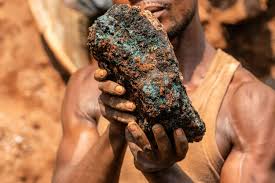DRC Risks Market Confidence in Bid to Enforce Cobalt Control
Congo’s new cobalt export quotas threaten exclusion for violators as the government asserts control over 70% of global supply. Prices (LME: COB ≈ USD 33,500) rose 3.4% as traders weigh state capacity against market credibility.

Congo’s latest move to tighten control over cobalt exports marks the most assertive intervention in global critical-minerals policy this year. The government will impose a quota-based export regime starting October 16, 2025, replacing the temporary suspension of export permits announced in September. Exporters that exceed their assigned volumes risk potential permanent exclusion from future participation—a signal that Kinshasa intends to reassert authority over a sector that supplies nearly 70 percent of the world’s cobalt but has long eluded full state oversight.
President Félix Tshisekedi’s administration is betting that strict quotas can formalize exports and reduce smuggling, which accounts for up to a third of national output. Draft government estimates place export allocations near 18,100 tonnes for 2025 and roughly 96,600 tonnes for 2027, covering licensed producers such as China Molybdenum (HKEX: 3993), Glencore (LSE: GLEN), and Eurasian Resources Group. These quotas, calibrated against historical shipments, aim to link export rights to traceable production. The approach mirrors Indonesia’s effort to govern nickel flows and aligns with calls from the African Development Bank and OECD for supply-chain transparency.
Market reaction has been swift but cautious. Cobalt (LME: COB) prices climbed about 3.4 percent to USD 33,500 per tonne, extending a rebound from June 2025 lows near USD 26,500. Fastmarkets data show visible inventories near 70,000 tonnes—ample by historical standards—indicating that the rally reflects precautionary positioning rather than genuine shortage. Analysts expect volatility to persist until the DRC proves it can enforce quotas consistently. Benchmark Mineral Intelligence notes that demand from China’s EV sector has slowed, with refinery utilization down to 82 percent, suggesting that fundamentals remain soft even as traders price in policy risk.
Enforcement, however, remains the system’s weakest link. The DRC’s cobalt ecosystem is dominated by artisanal mining and fragmented oversight. More than one-third of output originates from informal sources, often outside official monitoring or export documentation. Regulatory overlap between the Ministry of Mines, Gécamines, and provincial authorities further complicates traceability. Without real-time digital reporting and credible inspection mechanisms, sanctions may fall unevenly—risking disputes from legitimate exporters and encouraging rerouting through porous borders with Zambia and Tanzania. The government’s credibility will hinge on building administrative capacity, not on declarations of control.
For investors and refiners, the move adds sovereign risk to an already volatile commodity. China’s refiners—including Huayou Cobalt (SHA: 603799) and cell manufacturers like CATL (SHE: 300750)—process more than 70 percent of DRC cobalt through global supply chains. Any interruption in export licenses could ripple across battery production and trigger defensive restocking in Asia and Europe. While cobalt’s share in EV chemistries is gradually declining, it remains indispensable for high-performance cathodes used in premium vehicles. Futures spreads have narrowed, signaling market anticipation of logistical delays rather than sustained shortages.
Neighboring producers are watching closely. Zambia has revamped its Mining Cadastre and Minerals Regulation Commission to streamline licensing, while Indonesia—whose nickel ban forced local smelting—remains a contested but instructive precedent. The DRC faces a delicate balance: asserting resource sovereignty without deterring foreign investment needed for domestic value addition. The IMF, in its 2025 Article IV review, warned that unpredictable mining regulation could widen the fiscal deficit—currently around 4.5 percent of GDP—and strain reserves, which stand at USD 5.7 billion. Inflation has stabilized near 14 percent year-on-year, but capital inflows remain volatile, and investor sentiment hinges on regulatory stability.
The quota plan also carries political weight. With elections approaching, the government faces pressure to convert mineral wealth into visible development gains. Tough talk on export control plays well domestically but risks alienating key producers whose compliance determines the policy’s success. If enforcement falters, legitimate exporters could divert output informally, eroding both fiscal returns and governance credibility. The danger is that a framework designed to increase transparency might instead reproduce the opacity it seeks to eliminate.
For global commodity markets, Congo’s shift fits into a broader pattern of resource nationalism from Latin America to Southeast Asia. Governments are reasserting control over strategic materials, but the trade-off between sovereignty and investor confidence is tightening. In cobalt’s case, sustainable reform requires digitized tracking, standardized reporting, and coordinated enforcement across the Great Lakes corridor—steps that demand institutional investment, not decrees. Western automakers and financiers watching supply-chain ethics may welcome stricter oversight, but only if it is transparent, predictable, and enforceable.
Ultimately, the DRC’s quota regime represents both ambition and risk. It acknowledges the need to discipline a chaotic export system but may overestimate the state’s capacity to implement lasting reform. Whether it stabilizes cobalt markets or deepens volatility will depend not on rhetoric but on execution. For a country sitting atop the world’s largest cobalt reserves, the credibility of governance—not the volume of quotas—will determine how much of that wealth translates into durable national leverage.





